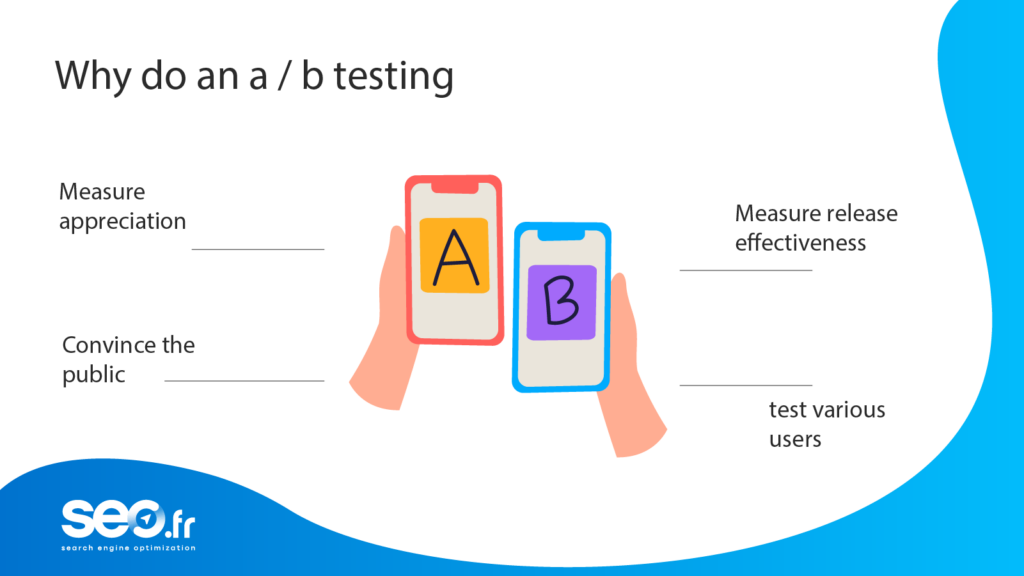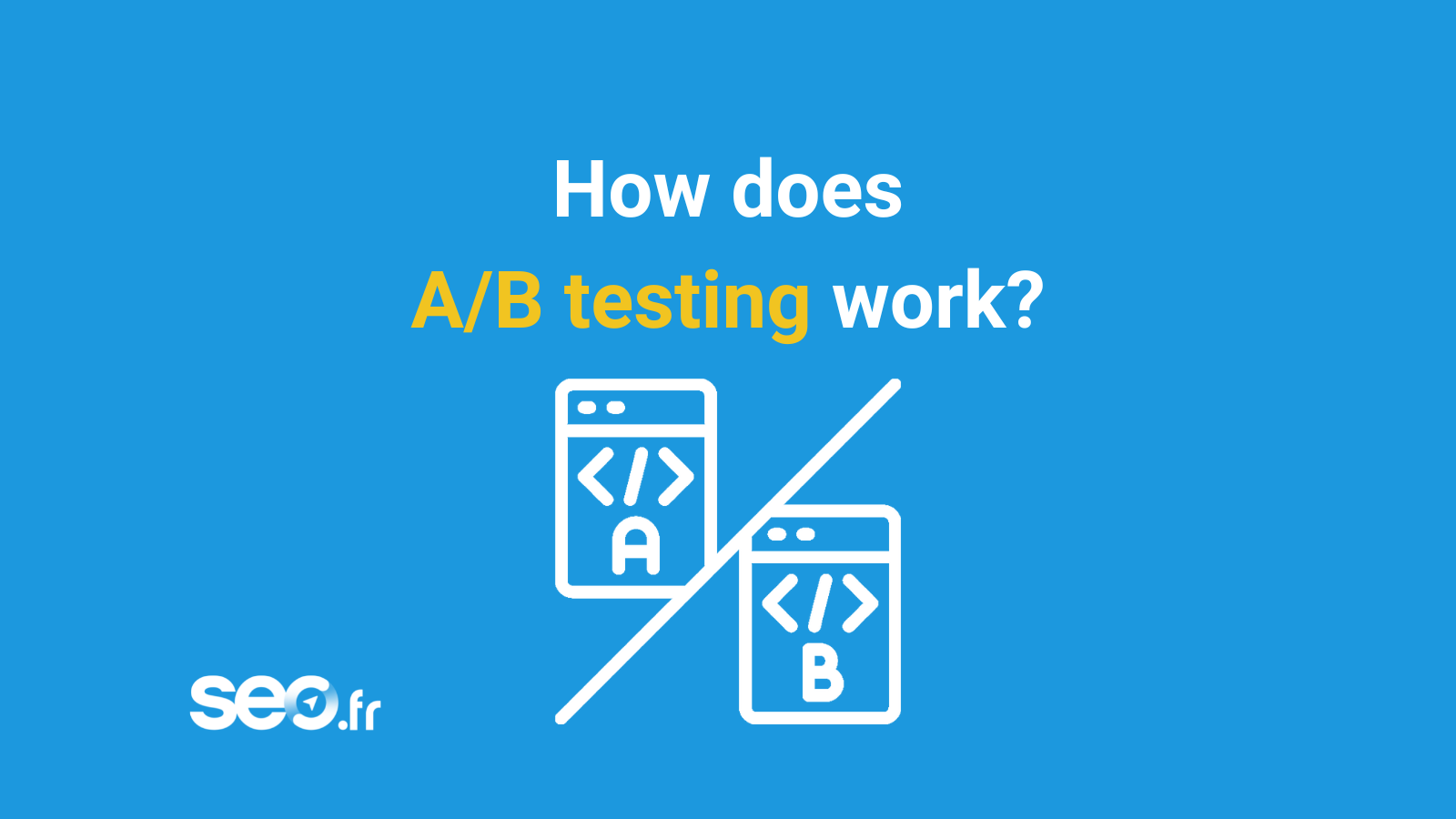Why A/B testing of web pages?
When implementing a marketing strategy, A/B testing is one of the levers not to be underestimated, whether in B2B or B2C!
A/B testing is a concept in digital marketing that consists of testing several versions of a web page. This process makes it possible to identify the best performing version and thus to improve your page. A/B testing offers many advantages. In particular, it allows you to make relevant decisions on the changes to be made to your website. This marketing strategy allows you to maximise conversions by identifying the elements that work best for your target audience. Don’t engage in poorly targeted advertising campaigns that cost you money. Identify what works with A/B testing!
Do you want to optimise your overall performance, but don’t know how to set up A/B testing? SEO.co.uk explains it all to you.
What is A/B testing in web marketing?
This web marketing strategy should not be done without first defining an objective. Furthermore, it is important not to change all the elements on version B. The purpose of the test is also to help you visualise what to prioritise and what to remove.
Good to know:
- The audience can be different depending on the page;
- A/B testing is not necessarily limited to two variants, it can be multivariate.

Increase your conversion rate with A/B testing
Have you noticed a high bounce rate on your page? A/B testing can help you to see this more clearly and to implement an appropriate response. Every page of every site is judged by the users. This is why the user experience should never be put aside.
Before being seen by an Internet user, your page must meet the criteria imposed by the search engines. The more interesting your page is judged by these algorithms, the better it will be indexed and therefore the more visible it will be in the results pages. A/B testing also makes it possible to determine the reaction of users. It is then up to you to use this data to devise your conversion strategy and attract new customers.
How to set up A/B testing in 5 steps?
A/B testing is commonly used via social media (e.g. Facebook ads), to test many elements, such as :
- call to action (CTA) buttons ;
- titles ;
- images ;
- forms ;
- prices of your products;
- emailing ;
- colours ;
- Pop-up windows;
- font sizes.
- Etc.
Everything has to be perfect to attract your targets and keep them coming back. With this in mind, you can use A/B testing to optimise landing pages or Google Shopping product pages, but also to test elements on any page of your website.
Your primary objective may be:
- Improve the conversion rate of your website;
- Increase your sales;
- Improve user satisfaction;
- etc.
Got an SEO question?
Geraldine can help
5 years of SEO expertise

Step 1: Establish a strategy
Here are the characteristics of your page or website that must be taken into account in your A/B testing:
- Its structure;
- Its architecture;
- Its textual content;
- Its graphic content;
- Its ergonomics;
- Its links, internal and external;
Since the latest Google update came into force, SEO content is more than ever a decisive element in the Google ranking of websites. It is therefore this aspect that should be tested as a priority in your A/B testing procedure.
Step 2: Create two concurrent pages
You need to create two different versions of your web page. As with any AB testing marketing, you can offer :
- Two types of usability ;
- Natural links and/or sponsored links of different origin or destination;
- Different visual presentations;
- Different SEO copywriting from one version to another;
You should then put both versions online to test first the reaction of the search engine crawlers and then the reaction of your two audiences. You will then ask yourself the following question: over a given period of time, which version generates more activity (clicks, traffic, conversion)?
You can also choose to entrust the A/B testing procedure to a professional SEO.

Step 3: Measure the effectiveness of the online versions
For a website, e-commerce or other, you can use a tool such as Google Analytics. More simply, you can send Google a query on the main keyword of the page studied, then on its secondary keywords. You will immediately be able to see which of these two versions has the best positioning in the SERP.
In addition to this, A/B testing can also include “user opinion” fields in each version of the website being tested. Then compare the feedback collected both in terms of the number and the substance of the ideas. This allows you to evaluate the positivity of the experience that people have had while visiting your website. This is the main purpose of A/B testing.
Step 4: Act on your results
Do you have a version that is clearly different from the other? You can deactivate the losing version right away.
Do you have similar results? Your test is not conclusive, but it is nevertheless interesting. This means that the variable on your page that you tested has no impact on its performance. You can then proceed to a new test by choosing another variable.
Step 5: Enjoy the benefits of your A/B testing
This strategy is simple to use, inexpensive to implement, but its results can be very profitable!
- Increase your traffic: by testing different title or meta description formulas.
- Increase your conversion rate: gain leads or customers by testing the look and feel of your CTAs.
- Reduce your bounce rate: by testing your visuals, the font of your content, the design of the page, etc.
- Reduce the shopping cart abandonment rate: by testing your product visuals, the presentation of delivery terms, etc.
Today, the visibility of a site on the web requires constant improvements in your performance. A place in the SERP can be lost very quickly if optimisations are not regularly made.
Thanks to A/B testing, you can be one step ahead of your competition!









